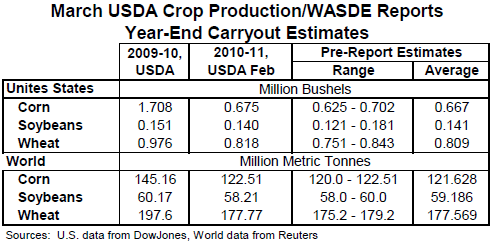



CME: Pre-Report Estimates for Latest USDA Reports
US - USDA’s Crop Production and World Supply and Demand Estimates (WASDE) reports will be released today (Thursday) at 8:30 a.m. EST, report Steve Meyer and Len Steiner.The table below shows analysts’ pre-report estimates for some of the key numbers regarding corn, soybeans and wheat. Note that we pulled the US estimates from Dow Jones’ survey (19 observations for corn and beans, 17 for wheat) and the world estimates for the survey by Reuters (8 observations for wheat and soybeans, 9 for corn).

As expected, none of this month’s estimates are significantly different from those of last month. Analysts apparently expect high prices to have a small impact on corn and soybean usage.
By far the most optimistic number in the table is the one for projected year-end world soybean stocks, which is roughly 1 million metric tonnes higher than last month. That number is driven primarily by an expected increase in the Brazilian soybean crop. A separate Reuters survey indicated that analysts expect the 2011 Brazilian soybean crop to be 69.781 million metric tonnes, 1.281 MMT higher than USDA’s February estimate. The analysts estimate that Argentina’s soybean crop will fall slightly from last month’s 49.5 MMT to 49.198 MMT. Analysts expect Brazil’s corn crop to remain steady at 51 MMT while the Argentine corn crop is expected to be 20.857 MMT, 5 per cent lower than last month’s USDA estimate of 22 MMT.
The trade will now focus on USDA’s March 31 Planting Intentions report to get its first real picture of 2011 US corn, soybean, wheat and cotton output. We again mention cotton because it will be a major player in acreage allocation decisions this year, especially in Southeastern states.
Planted acres may be step one but yields make or break a crop and there is plenty of concern about this year’s potential yields in light of the ongoing La Nina event. Iowa State University climatologist Dr. Elwyn Taylor pegs the “most likely” US corn yield for this year at 148 bu./acre. That is only 1 bu./acre higher than the poor weather yield from Darrel Good and Scott Irwin’s University of Illinois paper that we discussed yesterday. According to Dr Taylor, the ongoing La Nina is the third strongest on record, trailing only those of 1974 and 1989. The 1974 episode strengthened in March of that year and resulted in unfavorable yield conditions that summer. The ‘74 yield was roughly 16 bu./acre below the trend yield. The 1989 event declined in March and dissipated by June. 1989 corn yield was virtually even with the trend yield for that year.
Why is the US beef industry not responding to positive signals and showing signs of expansion? Or even more to the point — why did US cowmen liquidate so many cows last year when cow-calf operations were generally profitable and expectations should have been positive? Those questions have been batted around by a number of analysts over the past year and the first one was the subject of Dr. Derrell Peel’s March 7 “Cow/Calf Corner” published by the Oklahoma Cooperative Extension Service. Peel states that “The market is clearly trying to encourage cow-calf producers to rebuild cow herds. Yet there is no definitive indication that producers are retaining heifers at this time.” He offers two reasons for cowmen’s reticence:
- Excitement with current price levels but general skepticism that these prices will last. This feeling that current prices are a short run aberration which will soon be followed by a market correction belies the fact that the supply fundamentals underpinning the current market have been building for several years. He also points out that beef demand, though in his opinion not recovered from recessionary weakness, is moving the in the right direction. Add in strong export markets and he believes there is ample evidence that this is not short run price strength.
- Serious concerns that input prices will continue to increase and thus erase the profits gains from higher cattle prices. Peel observes that there is some fatalism in that belief — ie. no mater what a producer does, there is limited (or no) profit potential in cattle. But he points out that high cattle prices provide an opportunity to manage profitability by controlling things that can be controlled. “Agricultural producers have always had more opportunity to influence profitability by managing costs than by changing market prices,” he points out. Rising input prices beget adjustments and cattle are very flexible critters. Cowmen need to think broadly.








